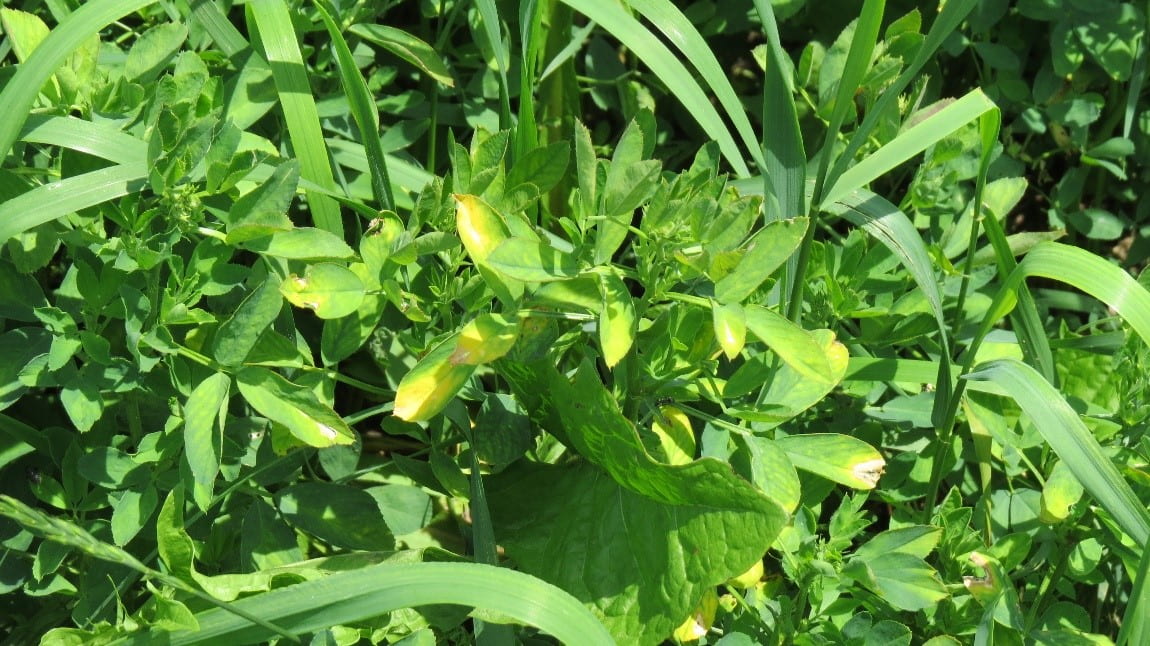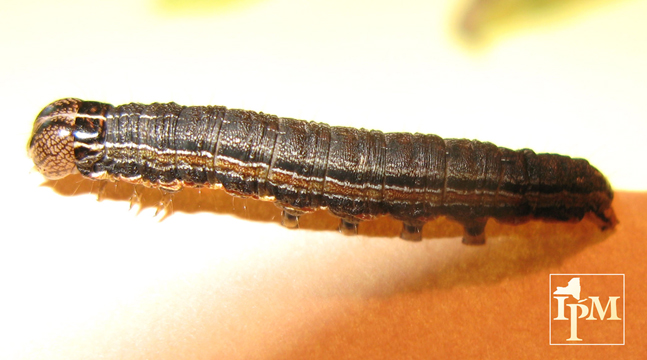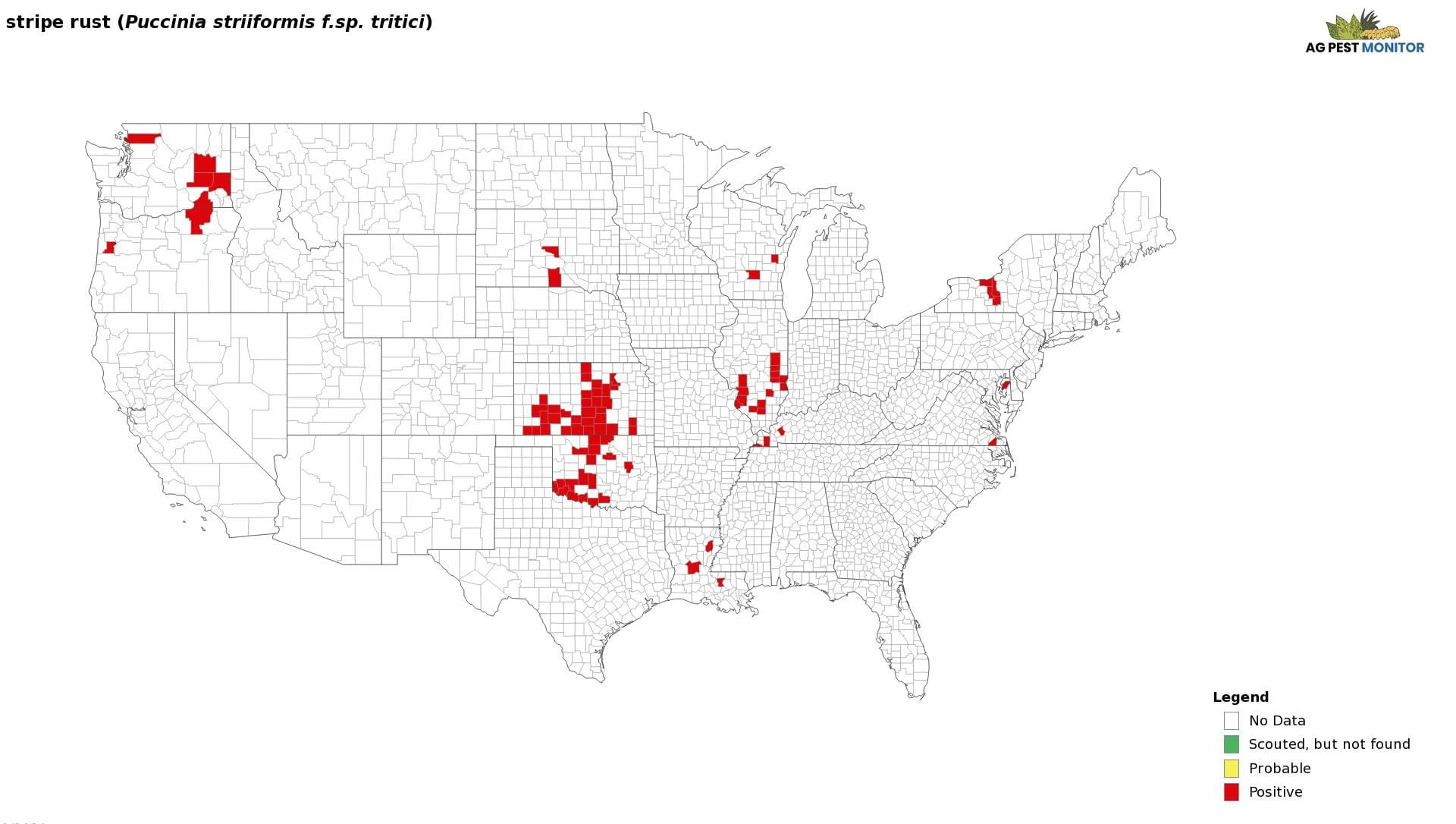Contents
View from the Field
Potato Leafhopper
Several Cornell Cooperative Extension Field Crop Specialists report potato leafhopper being over threshold in alfalfa. Potato leafhopper really thrives in hot, dry weather and populations can explode quickly. It is important to get out and check fields NOW! If you have a field over threshold, and is within a week to 10 days of harvest, the best thing to do is cut it and monitor the regrowth. Spraying after damage has occurred will not fix the yield or the quality of the specific cutting. For more information, please view the following video: IPM for Potato Leafhopper on Alfalfa-Video
Alfalfa Weevil
There are a few reports of alfalfa weevil over threshold in alfalfa regrowth. With the number of degree-days we have accumulated over the last week or so, the alfalfa weevil should be pupating soon and no longer feeding on the crop.
Alfalfa Weevil Damage
True Armyworm
Armyworm has been an issue in a few fields of corn and small grains. Kitty O’Neil (CCE Northern NY) reports a field over threshold for armyworm in corn. Lower levels of true armyworm have been found in small grains in western NY.
If you are over threshold for true armyworm and the larvae are still small, you might consider an insecticide application. A list of products that can be used for armyworm on corn, wheat, oats, barley, triticale, alfalfa, alfalfa/grass mix, grass, pasture and soybeans is provided below.
Black Cutworm
Aaron Gabriel (CCE Capital District) reports finding high levels of black cutworm in field corn. For more information on black cutworm please view the following video: Integrated Pest Management for Black Cutworm on Field Corn
Small Grain Diseases
Gary Bergstrom (Cornell University), Janice Degni (CCE South Central NY Team), Jaime Cummings (NYS IPM), Mike Stanyard (CCE Northeast Dairy, Livestock and Field Crops Team) and Christian Malsatzki (CCE Ulster County) report low levels of several diseases in small grains.
Wheat stripe rust has now been confirmed in four counties in New York, as reported by Gary Bergstrom.
Cereal Leaf Beetle
Gary Bergstrom (Cornell University), Janice Degni (CCE South Central NY Team), Jaime Cummings (NYS IPM), Mike Stanyard (CCE Northeast Dairy, Livestock and Field Crops Team) and Christian Malsatzki (CCE Ulster County) reports cereal leaf beetle in small grains. The infestations range from low to high.
Black Cutworm and True Armyworm flights from April to June
Weekly moths caught in pheromone traps weekly across New York State
Alfalfa Weevil and Base 50 F Degree Days
June 19, 2020
Stage
Alfalfa Degree Days Life Stages
(Base Temperature 48F)
Egg Hatch 280
Instar 1 315
Instar 2 395
Instar 3 470
Instar 4 550
Cocooning 600
Pupa 725
Adult Emergence 815
Black Cutworm and True Armyworm Degree Days
June 19, 2020
Black Cutworm Degree Days (Base 500 F) Lifecycle Growth Stages
Degree Days Stage Feeding Activity
0 Moth Capture Egg Laying
90 Eggs Hatch
91-311 1st to 3rd Instar Leaf Feeding
312-364 4th Instar Cutting Begins
365-430 5th Instar Cutting Begins
431-640 6th Instar Cutting Slows
641-989 Pupa No feeding
Source: University of Minnesota Insect Pest of Corn-Stand Reducers Black Cutworm
True Armyworm Degree Days (Base 500 F) Lifecycle Growth Stages
Degree Days Stage Feeding Activity
0 Moth Capture Egg Laying
113 Eggs Hatch
612 Larval stages Leaf Feeding
909 Pupa No feeding
True armyworm insecticides registered in NYS for field crops
Armyworm Field Crop Insecticides for NYS
Clipboard Checklist
Keith Waldron, NYS IPM
General
*Walk fields to check general field condition, weed issues
*Watch for crop maturity, stand assessments, weed escapes, lodging issues
Alfalfa:
*Evaluate established legume stands for approximate days until harvest
*Monitor potato leafhopper
*Monitor new seedings for potato leafhopper, pythium blight, phytopthora root rot.
Small Grains:
*Monitor winter grain fields for growth stage, disease issues, cereal leaf beetle
*Check stands for diseases, cereal leaf beetle, weed escapes
*Monitor winter wheat and winter malting barley for signs of Fusarium Head Blight
*Monitor spring grains for potential risk of fungal diseases – consult Fusarium Head Blight prediction model
Corn:
*Conduct plant population assessments, early season corn pests including seed corn maggot, white grub, wireworm, black cutworm, armyworm, slugs, diseases, weed issues, vertebrate damage
Soybeans:
*Post emergence weed evaluation, timely cultivation and/or weed management
*Conduct plant population assessments, early season corn pests including seed corn maggot, slugs, soybean aphid, diseases, weed issues, vertebrate damage
Pastures:
*Check and mend fences as needed.
*Check crop growth
*Invasive species, plants harmful to livestock
*Review/Plan rotation system
Equipment:
*Remove / clean soil and crop debris from equipment
*Arrange for custom weed control or check your own application or cultivator equipment for repairs.
*Carry appropriate / necessary NYS DEC and EPA required documents: (pesticide applicators license, pesticide labels, MSDS sheets, etc.) with application equipment
*Calibrate:
- planting equipment – maintain records on planting rate per field
- manure spreaders – maintain records on amount spread per field
- pesticide application equipment – Check nozzles, pumps, etc., recalibrate pesticide application equipment before use. Maintain pesticide use records
Storage:
* Check stored grain bins for temperature, moisture and signs of mold and insects. Aerate, core, transfer grain or treat as necessary
*Check forage allocation and anticipate feed program adjustments as forages from previous year are used up
*Plan where forages should be stored for optimum allocation next feeding season
*Mow around storage bins and facility to minimize pest hiding places
Dairy Cattle Barn Fly Management:
*Monitor animals and barn area for house fly, stable fly and other pest management needs including presence of rodents and birds.
*Check facilities for favorable fly breeding conditions: (organic matter + moisture): leaks in watering systems, roof gutters for leaks and potential overspill, drainage,
*Sanitation, sanitation, sanitation – clean animal resting areas, feed troughs, minimize source of moist organic matter i.e. fly breeding areas in barn and in adjacent animal loafing yard
* Continue fly monitoring: install “3X5″ index card fly speck monitoring cards throughout barn
*Use, replenish, replace fly management materials: sticky fly tapes/ribbons, insecticide baits, natural enemies (parasitoids), fly population monitoring (3 x 5) spot cards
*Consider purchase and release of Muscidifurax raptor and/or M. raptorellus natural enemies of house and stable fly pupae.
Dairy Cattle on Pasture:
*Monitor animals for presence of face flies, horn flies and stable flies. Action guidelines: face flies (average 10 per animal face), horn flies (average 50 / dairy per animal side, 200 / beef cattle per animal side), stable flies average 10 per animal (all four legs)
*Check feed bunk / water source locations for signs of stable fly breeding (moist undisturbed organic matter – spilled feed, round bales, etc.), minimize source of moist organic matter i.e. fly breeding areas in barn and in adjacent animal exercise yard.
*Check pasture for forage quality / quantity, rotate as appropriate
*Check pasture for vegetation poisonous to livestock
*Consider use of pasture fly traps to help reduce deer, horse and stable fly populations









